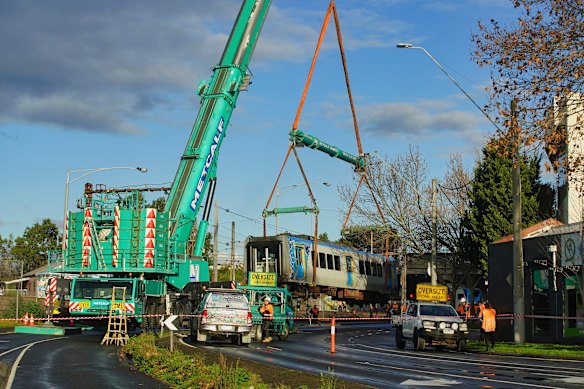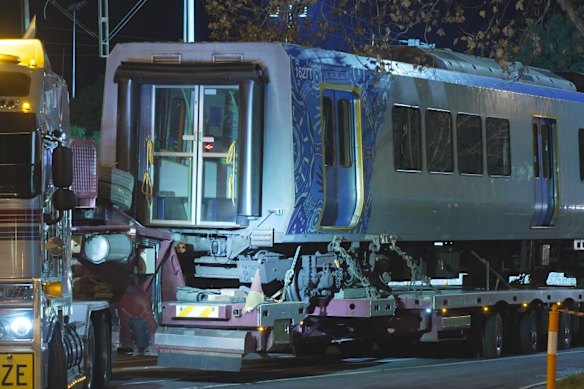Derailed train leaves 100m of damaged track as commuter chaos drags on
By Patrick Hatch and Angus Delaney
A Metro train that derailed at Clifton Hill on Sunday hit multiple trackside pillars and damaged about 100 metres of track, the nation’s peak safety investigator has disclosed, revealing the extent of repairs needed before service can resume on two of Melbourne’s busiest lines.
Metro chief executive Raymond O’Flaherty again apologised on Wednesday to the more than 100,000 passengers who travel on the Mernda and Hurstbridge lines every day, and said he was confident service would resume on Monday.

The train carriage is removed from the tracks on Tuesday afternoon after derailing at Clifton Hill on Sunday evening.Credit: Luis Enrique Ascui
A carriage on a city-bound X’Trapolis 100 came off the tracks between Rushall and Clifton Hill stations about 10.30pm on Sunday, bringing rail services in Melbourne’s north-east to a standstill. Damage to the carriage’s bogie and a wheel was so extensive that the carriage could only be removed by a crane, which lifted it from the tracks on Tuesday afternoon.
The Australian Transport Safety Bureau confirmed on Wednesday that Victoria’s Office of the Chief Investigator had launched an investigation into the derailment under a collaboration agreement between the two agencies.
The bureau’s involvement means Victoria’s investigators will have stronger powers offered under the Commonwealth Transport Safety Investigation Act, including the power to compel evidence, reflecting the serious and complicated nature of the incident.
The bureau said the train had hit multiple stanchions carrying overhead wires – rather than a single stanchion as previously believed – resulting in “substantial damage to the overhead infrastructure”.

The derailed carriage is removed by truck on Tuesday evening.Credit: Nine News
“About 100 metres of track and one passenger car were also significantly damaged,” it said in a statement. The bureau said it would release a preliminary report in about two months.
The last major derailment on Melbourne’s passenger train network was in February 2016, and occurred on a sharp bend between Merri and Rushall stations – about 600 metres before the site of Sunday’s derailment. The earlier incident also involved an X’Trapolis train.
An Australian Transport Safety Bureau investigation found that derailment was caused by a sharply angled joint on the track and the train’s wheels being insufficiently lubricated. Lubricators were not being maintained adequately after Metro took the work off contractors and brought it in-house, it found.
Four carriages on a Metro train derailed on a section of the Lilydale line between Mooroolbark and Croydon in January 2013. In that incident, the track and rails had buckled out of alignment due to heat-induced stress on a 37-degree day.
The Office of the National Rail Safety Regulator is also investigating the latest incident. It would ensure Metro could manage all safety risks before restarting services on the tracks, a spokesperson said.
In a morning media blitz, O’Flaherty, the Metro chief executive, apologised for passengers experiencing travel times that were “a lot” longer as a result of Sunday night’s derailment.
Passengers have been urged to allow an extra 45 minutes of travel time each way on the Mernda and Hurstbridge lines. Replacement buses will remain in operation until Monday.
“I actually acknowledge that this is causing significant inconvenience to over 100,000 of our passengers on a daily basis, and these are two of our busiest lines, and I want to apologise to all of our passengers affected, and I know their journey times are a lot more this week,” O’Flaherty told radio station 3AW.
Commuters have complained of overcrowded trams as regular train users seek alternative transport.
O’Flaherty said passengers would be entitled to compensation if the line suspensions pushed Metro below its monthly reliability targets, which are calculated on a network-wide basis.
No one was injured in the derailment. The use of a crane at the site on Tuesday afternoon to remove the derailed carriage allowed Metro Trains to assess the extent of the expensive damage.
“We had to commission a special crane to come in and lift that away from the site. But obviously, it was a very complex operation,” O’Flaherty told 3AW.
Rail safety investigator Phillip Barker previously told The Age that the extent of damage to the train’s bogie and how far the carriage swung away from the tracks were both highly unusual.
The Department of Transport and Planning said Hurstbridge line passengers would need to use buses between Eltham and Parliament stations, while Mernda line passengers would use buses between Reservoir and Parliament until the last service on Sunday.
Buses had already been operating on the Hurstbridge line between Heidelberg and Eltham due to planned works, which will continue until July 24.
Start the day with a summary of the day’s most important and interesting stories, analysis and insights. Sign up for our Morning Edition newsletter.
correction
This story originally quoted Metro Trains chief executive Raymond O’Flaherty as saying he apologised to passengers whose travel times are “a little longer” due to the train derailment. It has been corrected to indicate O’Flaherty apologised for passengers experiencing travel times that were “a lot” longer due to the derailment.